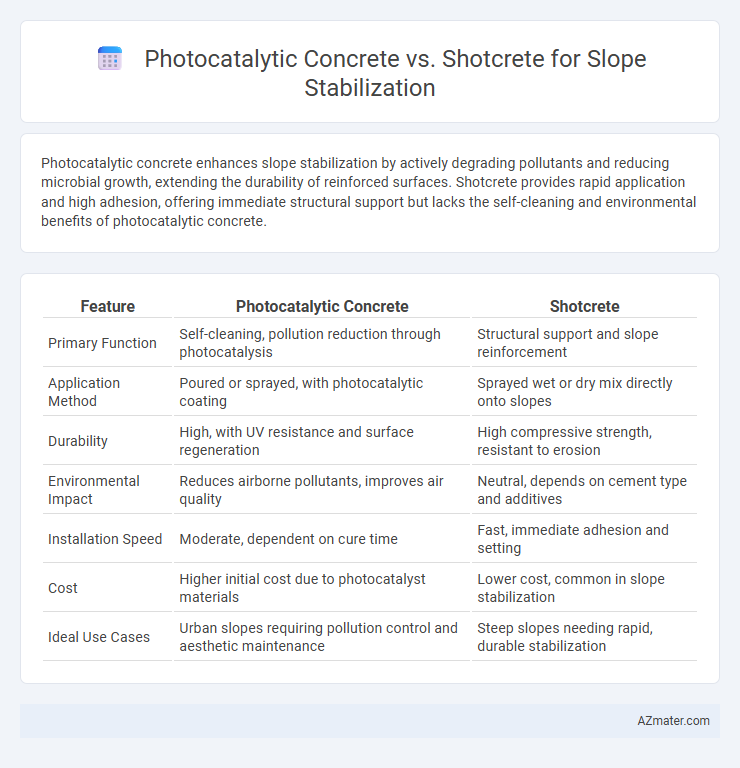Photocatalytic concrete enhances slope stabilization by actively degrading pollutants and reducing microbial growth, extending the durability of reinforced surfaces. Shotcrete provides rapid application and high adhesion, offering immediate structural support but lacks the self-cleaning and environmental benefits of photocatalytic concrete.
Table of Comparison
| Feature | Photocatalytic Concrete | Shotcrete |
|---|---|---|
| Primary Function | Self-cleaning, pollution reduction through photocatalysis | Structural support and slope reinforcement |
| Application Method | Poured or sprayed, with photocatalytic coating | Sprayed wet or dry mix directly onto slopes |
| Durability | High, with UV resistance and surface regeneration | High compressive strength, resistant to erosion |
| Environmental Impact | Reduces airborne pollutants, improves air quality | Neutral, depends on cement type and additives |
| Installation Speed | Moderate, dependent on cure time | Fast, immediate adhesion and setting |
| Cost | Higher initial cost due to photocatalyst materials | Lower cost, common in slope stabilization |
| Ideal Use Cases | Urban slopes requiring pollution control and aesthetic maintenance | Steep slopes needing rapid, durable stabilization |
Introduction to Slope Stabilization Techniques
Slope stabilization techniques involve methods to prevent soil erosion and landslides on inclined terrains by enhancing structural integrity and surface protection. Photocatalytic concrete incorporates titanium dioxide, facilitating pollutant degradation and maintaining cleaner, more durable slopes, whereas shotcrete is a sprayed concrete applied for immediate soil reinforcement and erosion control. Both methods contribute to slope stabilization, with photocatalytic concrete offering environmental benefits and shotcrete providing rapid physical support.
What is Photocatalytic Concrete?
Photocatalytic concrete is a type of concrete embedded with titanium dioxide (TiO2) particles that activate under sunlight to break down pollutants and organic matter on the surface, thereby reducing environmental contamination. This self-cleaning, air-purifying property enhances slope stabilization by minimizing surface runoff pollution and promoting long-term durability. Unlike shotcrete, which primarily provides mechanical protection and structural reinforcement, photocatalytic concrete offers added environmental benefits through its catalytic oxidation processes.
Overview of Shotcrete in Slope Engineering
Shotcrete, a pneumatically applied concrete, is widely used in slope stabilization due to its rapid application and strong adhesion properties. This method provides immediate structural support and erosion control by forming a continuous, dense layer that conforms to uneven surfaces. Its versatility allows reinforcement with fibers or mesh, enhancing slope stability and durability in challenging geotechnical conditions.
Mechanisms of Action: How Each Method Stabilizes Slopes
Photocatalytic concrete stabilizes slopes by utilizing titanium dioxide (TiO2) particles that break down organic pollutants and reduce surface erosion through photocatalytic reactions activated by sunlight, enhancing slope durability and environmental quality. Shotcrete stabilizes slopes through mechanical reinforcement, where sprayed concrete consolidates loose soil or rock particles, providing immediate structural support and preventing slope failure by distributing loads evenly. The mechanisms differ with photocatalytic concrete leveraging chemical degradation to improve surface properties, while shotcrete relies on physical bonding and structural encapsulation for slope stabilization.
Environmental Impact: Photocatalytic Concrete vs Shotcrete
Photocatalytic concrete significantly reduces environmental impact by actively degrading air pollutants such as nitrogen oxides (NOx) through its titanium dioxide (TiO2) content, promoting cleaner surrounding air during slope stabilization. Shotcrete, primarily composed of conventional cementitious materials, lacks this pollutant-degrading capability and may contribute to localized dust and CO2 emissions during application. The use of photocatalytic concrete supports sustainable infrastructure development by enhancing air quality and minimizing carbon footprint compared to traditional shotcrete methods.
Durability and Longevity Comparison
Photocatalytic concrete enhances durability by reducing surface pollutants and self-cleaning, which slows deterioration caused by environmental factors. Shotcrete offers immediate structural support and excellent adhesion on slopes but may require more frequent maintenance due to exposure to weathering and erosion. Both methods provide effective slope stabilization, yet photocatalytic concrete tends to exhibit superior longevity due to its advanced resistance against microbial growth and chemical degradation.
Cost Analysis: Initial Investment and Maintenance
Photocatalytic concrete incurs higher initial investment costs compared to shotcrete due to advanced material components like titanium dioxide nanoparticles that enhance pollution reduction and self-cleaning properties. Maintenance expenses for photocatalytic concrete are lower over time as its surface actively decomposes organic pollutants and prevents grime buildup, reducing cleaning frequency and costs. Shotcrete offers a more cost-effective upfront solution but demands more frequent maintenance and repairs to address surface deterioration and potential environmental wear on slopes.
Installation Methods and Site Suitability
Photocatalytic concrete involves spraying or casting a photocatalytic mix that actively breaks down pollutants, requiring controlled curing and specific environmental conditions to optimize its catalytic properties. Shotcrete is applied by pneumatically projecting concrete onto slopes, offering fast placement and strong adhesion suitable for uneven or inaccessible terrain. Site suitability depends on slope geometry and environmental goals, with photocatalytic concrete favored in urban areas for pollution mitigation and shotcrete preferred for rapid stabilization on complex or steep slopes.
Case Studies of Slope Stabilization Projects
Photocatalytic concrete demonstrated significant self-cleaning and pollution-reducing properties in slope stabilization projects such as the HK highway rehabilitation, improving long-term durability and environmental impact. Shotcrete has been widely applied in steep slope reinforcement cases, including the Swiss Alps tunneling projects, offering rapid application and immediate structural support but limited environmental benefits. Comparative case studies highlight photocatalytic concrete's dual function in erosion control and air purification, whereas shotcrete excels in urgent, high-load scenarios without advanced pollution mitigation.
Future Trends and Recommendations in Slope Engineering
Photocatalytic concrete offers promising advancements in slope stabilization by integrating self-cleaning and air-purifying properties, reducing environmental impact compared to traditional shotcrete methods. Future trends in slope engineering emphasize the development of eco-friendly materials with enhanced durability and pollutant degradation capabilities, positioning photocatalytic concrete as a sustainable alternative. Recommendations include combining photocatalytic technology with smart monitoring systems to improve long-term stability and resilience against environmental stressors.

Infographic: Photocatalytic concrete vs Shotcrete for Slope stabilization
 azmater.com
azmater.com